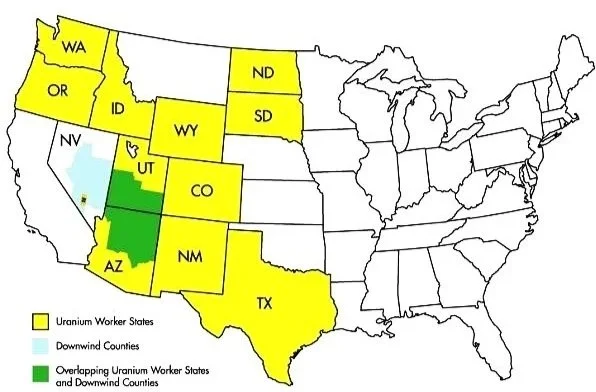What is RECA?
RECA is a bipartisan program established in 1990 that provides partial restitution for the devastating health impacts of radiation exposure from U.S. nuclear weapons testing and production. The U.S. government bears responsibility for the downwinders, uranium workers, and atomic veterans whose lives and health were sacrificed for our national security.
We know from scientific studies and first-hand accounts that currently, RECA does not go far enough. Though RECA was significantly expanded in 2025, highly irradiated places such as Montana, Colorado and Guam were left out, and many victims of nuclear production and waste storage have never been included.
What resources were available before 2025?
Downwinders — those exposed to fallout from nuclear testing - from certain counties in Arizona, Nevada, and Utah were eligible for $50,000 (green and blue areas on the map).
“Onsite participants” of atmospheric nuclear weapons tests — many of whom are also known as atomic veterans — were eligible for $75,000.
Uranium miners, millers, and ore transporters who worked in the uranium industry from 1942 to 1971 (in the yellow states on the map) were eligible for $100,000, as well as additional benefits through the EEOICPA.
No-cost medical screenings for compensable illnesses at select clinics through RESEP.
RECA Covered Areas from 2000-2024
How did the United States expose RECA claimants to dangerous radiation?
From 1945 - 1962, the U.S. government conducted over 200 above-ground nuclear tests. Winds carried nuclear fallout hundreds of miles away from the test sites, exposing local communities to unsafe levels of radiation.
Beginning in the late 1940s, uranium workers - many of whom were Indigenous - were unknowingly exposed to dangerous levels of radiation while working to produce materials for America’s nuclear arsenal.
Hundreds of thousands of service members were also exposed to radiation through nuclear weapons testing and the cleanup of radioactive materials.
Starting with the Manhattan Project in the early 1940s, the production of nuclear weapons created environmental contamination and radioactive waste, which in many cases exposed communities surrounding production sites to radiation and other toxins.
RECA Factsheets and Resources
Overview
One-page overview of U.S. nuclear weapons activities and the Radiation Exposure Compensation Reauthorization Act - S. 3853
House Cosponsor List
View the U.S. House cosponsors of RECA Amendments (H.R. 4426) in the 118th Session
Senate Cosponsor List
View the U.S. Senate cosponsors of the RECA Amendments (S. 1751) in the 118th Session
About Us
Our movement brings together affected community members, policy advocates, and concerned citizens to speak out about the need to further extend RECA and strengthen coverage to support previously excluded communities and individuals.
RECA expired in June 2024, and then was reinstated and significantly expanded in July 2025. However, the existing program is still flawed, and many communities are still fighting for inclusion in the program.
Photo: Blake McCord, Grand Canyon Trust

